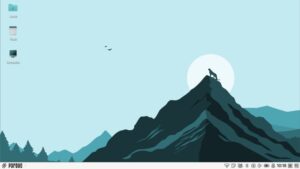The first of anything is usually the best. Not always, but usually.
The way we figure it, that includes the first time a person installs and uses GNU/Linux. Wasn’t that a special experience? We know it was for us.
For many of us, there are a lot of “firsts” tied up with that virgin install of a Linux distribution. For some it might be a first experience partitioning a hard drive. Back when most of us here were doing our first Linux installation, part of the FUD out of Redmond was that partitioning a disk was no territory for non technical types like us. We even remember hearing warnings on local “computer talk” radio shows, warning us to not even think about trying to partition a drive ourselves. Somehow, though, we all managed to survive with our existing file systems intact, even though a few of us will admit to having been white knuckled nervous Nellies at the time.
Another big first, and we do mean a big first, is that the first Linux installation might be for some the first up close and personal experience with a computer running anything other than a Redmond or Cupertino product. That, of course, wouldn’t be true for everybody, since many of us come from the time before the “IBM compatible PC,” when practically every brand of consumer computer came with it’s own OS. But for those who both never worked in IT and who came of age post Windows 95, Windows and/or some version of the Mac OS might represent the sum of all computer operating system experience.
| [yop_poll id=”18″] |
Then there’s that other great first, that first look at some of the great free and open source software that ships with Linux distributions, opening a world that had up until then been nonexistent. Remember the rush, when your first installation was complete and you watched your computer boot into the strange new world of whatever desktop environment was the default on your new chosen distro? How exciting it was, searching through the menu, clicking on this, clicking on that, having a first look at GIMP, AbiWord, Evolution, KMail, Konqueror, Galeon and more. Wow! How weird it was to discover browsers not branded as Internet Explorer or Netscape, full featured photo editing without the Adobe imprint, and office suites that had nothing to do with Microsoft or WordPerfect.
What distro was your first Linux date?
For our poll, there’s absolutely no way we can list every single GNU/Linux distro that might qualify–we’re not even going to try. What we’ve done is take a cue from last week’s FOSS Force Poll and offer the top ten distros from the “Page Hit Ranking” on DistroWatch. Those of you who’s first distro wasn’t one of these ten, which we assume will be most of you, just need to select “Other” and type in the name of the distro you consider your first. Don’t type in more than one name or we won’t count your vote–we just want the very first distro with which you “went steady.”
We’re also especially interested in your thoughts and comments on your first experiences with the penguin. You can feel free to share those with us by using the comment section below this article.





Absolutely the first was SuSE. still have the install disk.
My first distro was not my first real experience. That came later with the first full-on dive right in (format the whole HD) experience, when I inherited a brand new Vista computer that the previous owner couldn’t stand. After dual booting Ubuntu for a month or 2 I decided I had absolutely no reason to ever use Windows, and in fact I was so frustrated at how horrid it was to contend with a black screen of death. All the software I used in Windows (Audacity, GIMP, Open Office) was easier to install in GNU/Linux (thanks to the software center (find things I don’t know about) and Synaptic(install lots and lots of things) and gnome-terminal (quick updates, quick installs of specific things)).
It was Fedora…..version 13…and I WAS nervous….mind you the computer iwas installing it on was just a “tester”…and there was nothing on it that I had a dire need for…but still jumping in the FOSS pool with my eyes closed and feet firts?…was a heart-racing experience!. I got SO nervous…I installed Windows XP right over it, for fear that I had done some terrible IT deed!! LOL! then after sleeping on it for a day more…I went aheac and reinstalled it over XP and I haven’t looked back since! I apologize for those who think I sound like a fan-boy, but I really DO love my Fedora laptop, it does everything i need it to….and nothing I DON’T!…(BSOD’s come to mind! LoL!)
Soft Landing Systems was my escape from MS-Windows 3.1. I played with Minix for a while, but it was never meant to be a production level system. SLS 1.2 (kernel 0.99pl12) gave me a fully functional computer again. After they folded their tent, I switched to Slackware without missing a beat. I have found nothing since to cause me to switch again.
Any GUI slows me down when trying to do real work. They may look nice and be easy for newbies to navigate, but there are too many things they can’t do. Using them is a lot like putting a governor on a Ferrari and setting it to 55 MPH (90 KPH). Yes, you will eventually get where you want to go, but you’re going to be frustrated and upset long before you do. Give me a command line with bash, awk and Perl so I can actually get some work done.
OOoohh yeah, the top ten distros from distrowatch’s last month is going to be really good at defining which distro was our *first* time with Linux. Unless you’ve only been here for one month, that is.
Where are “the ancestors” ? C’mon ! It couldn’t be that hard to at least include some of them. At least Red Hat.
Back in 99 I had picked up a book at a used book store on Slackware. It was missing the CD. Being on dial up back then I ordered a set of 10 CDs with different distros on theme .
The first distro I tried was Slackware, the seconod was RedHat.
First impressions. It was a lot of work to find the frequencies for my monitor so I could hand craft a working xorg.conf. Second, I could only stand the look of Gnome1 for about 2 hours before switching to KDE1.
Corel Linux
(circa 2000)
Wow! This article really took me back. Remembering the days of installing Red Hat and Mandrake.
What a time and the best move that was made in my computing life. It was a steep learning curve, at the time, but it was “vErY” worth while.
Thanks for returning the memories. 😉
The first distro I tried was Slackware, but I could not get it to work correctly. Caldera was my first successful installation, which I chose primarily because WordPerfect would run on it, and I had a free copy. In those days, Linux was just for fun.
By 2000 or 2001, Red Hat and SuSE were the workhorse distros that ran all of the computers in my house except for a Windows development machine.
i am a bit surprised that slackware is not in this list. i am pretty sure that most of those “other” votes are for slackware.
my first was SLS (hi bob) though, followed by redhat and debian, and now foresight.
greetings, eMBee.
Caldera. It was at work, we had a Netware 4.11 system, owner was too chaep to “upgrade” to Windows Server. Early versions on Caldera had very snazzy Netware client software. Turns out they did not own it, the lad who had written it had defected to Suse. I later turned to RedHat (pre Fedora), that had adaquate Netware file system support.
@eMBee Rather than try to pick and choose which distros our reader’s might’ve first used and maybe hurt some feelings by leaving some people out, we decided to remain neutral by falling back on the DW “Top 10” list. We knew this list would be practically useless, as most of the distros on today’s top ten didn’t even exist not so long ago, which has really proven to be true–with “Other” now receiving over 60% of the vote.
Just a little forecasting for you. Right now Red Hat and Slackware are leading in the “Other” category. In a couple of weeks, after the voting is over, we’ll be posting a detailed look at the results. 🙂
The listed are all recent distro’s, probably why “other” is dominating. My first Linux was .9 something or another, given to me by a customer on a floppy disk. My first real Linux was Slackware around 1995, though I didn’t know it was Slackware, I just knew it as Linux. Downloaded from Vax VMS machines to floppy disks. Installing X from floppy, not that was fun
I would say I tried in order:
1. Slackware
2. Redhat with CDE
3. Mandrake fork of Redhat with KDE
4. Enoch
I stuck with Mandrake then Enoch/Gentoo for a while and contributed to the projects also, but I am using Ubuntu mostly now.
I installed Ubuntu 8.04 (Hardy Heron) 5 years ago. I have stuck with Ubuntu and its derivatives (Peppermint, Mint, Ultimate Edition) since then, liking the Debian way of things.
Currently, rocking Kubuntu 13.04 and loving KDE more than I thought I would.
**Unity, GNOME 3 Hater*
Ubuntu it was, funny how the reason for going GNU/Linux was music production. Windows has great software but the latency of Midi instruments is ridiculously large, I was using a friend’s MacBook Pro for a bit thinking how great his sound card was before accidentally stumbling upon the specs: the sound card was the same if not worse than the one I had on my laptop, so I figured it’s the OS and that was the best decision of my life. First I only used GNU/Linux to play the midi keyboard but over the time I realize that I boot the Windows partition less and less, until eventually I abandoned it completely. Since, I’ve gone completely crazy distro hopping, to try every DE and package manager, mostly trying easy, out of the box distros. FAvourites so far are Fedora and Mint. I think the next logical step is to go with Arch or Gentoo, the world of Linux is just so vast, interesting and great!
SLS followed by Slackware. Tried RH and SuSE (back when it was a slackware based distro). There was also Yggdrasil, but didn’t play with it long. Still using Slackware. I remember the fun of d/l all those floppies for SLS and the feeling of being in heaven when the Slackware CD set came out.
I’m not sure when I started, but I do have a copy of Red Hat 5.2 that was my first installed distro. Everything I did was at the command line then, I don’t think I even installed a graphical interface at first.
I clearly remember floundering for half a day trying to figure out how to copy some files to a floppy disk – I had never heard of the concept of mounting a drive, and could not figure out why things didn’t work. Good times. I was actually pretty excited about it, when I did finally figure out what was needed. As with all the other difficult stuff – it was all worth it in the end. I learned a lot about being self-suffcient and getting help from the community during that process.
I first ran RedHat think was RedHat 3 maybe was 4. Back in the mid 90’s I enjoyed it though always had trouble getting sound to work with that if i recall Though really didnt try linux again till after ubuntu got huge maybe version 08.04 then on and off since then.. Now since windows 8 and all the latest news with security and privacy im onto Debian 7 and LMDE.. Like Debian for server light and fast super stable… Mint Debian for desktop currently. Both aim tobe complete replacements. Nice linux has come a long ways and less worry about stability and security
@wub “I learned a lot about being self-suffcient and getting help from the community during that process.”
We really liked that! 😉
I started with linux using winlinux that installed like a normal program in windows 98. Then moved onto Mandrake, slackware, debian, ubuntu, arch, and now Linux Mint 15.
Calculate
Like Bob McConnellmy first install was SLS with the 0.99pl12 kernel. That was back in 1993.
Since which time i’ve tried dozens of distros, although since about 1998 I have avoided RPM-based distros.
Currently all my systems (and my wife’s) are running Mint. It’s easy and frankly I have other things to do than piss about playing with config files and the like (been there, done that, got the T-shirt, using it for dusters).
My first Linux distro was Red Hat Linux 3.something. No, not Red Hat Enterprise Linux, I mean the original Red Hat circa 1995. I also picked up a copy of Slackware at the same time from the same store. Yes, we bought distros back then because there was no broadband and yes, Slackware was in stores. Yggdrasil was on the shelf back then too but I never did try it.
Slackware in ’94.
My first distro was Debian 3.1 Sarge in February 2005, then still in “testing” (although it would go stable a few months later). Boy, I had all sorts of problems getting it installed on my system, and I spent two weeks installing, re-installing, and searching for help online because I knew I was messing something up (the system was unbearably slow, none of my USB devices worked, the system would often lock up on me, and I could never shut it down properly because it would always lock up during shut down). Finally someone made a suggestion that led me to accidentally discover that there was a special kernel specifically for 32-bit AMD systems. All my system problems went away once I installed that, but the fact that I never found any documentation pointing me to that kernel, nor did anyone suggest that it existed, left a bad taste in my mouth with Debian (I was fully up-front with all my system specs and what I had installed when seeking help). A few months later, I tried Ubuntu 5.10. It worked on my system “out of the box”. I’ve been with Ubuntu ever since.
Mandrake 6.0 or 7.0 box set I bought at Target.
1997, Caldera at school, which led to Slackware at home.
I voted Other / Slackware.
That’s not actually the first distro I installed but it’s the first I really used. I think it was 7.0 or maybe 7.1.
The very first distro I installed was Conectiva 3.0, then I tried Turbolinux (can’t remeber what version right now) but I cloud hardly use them.
Actually, I really liked them but couldn’t get X working, so I moved on to Slackware 🙂